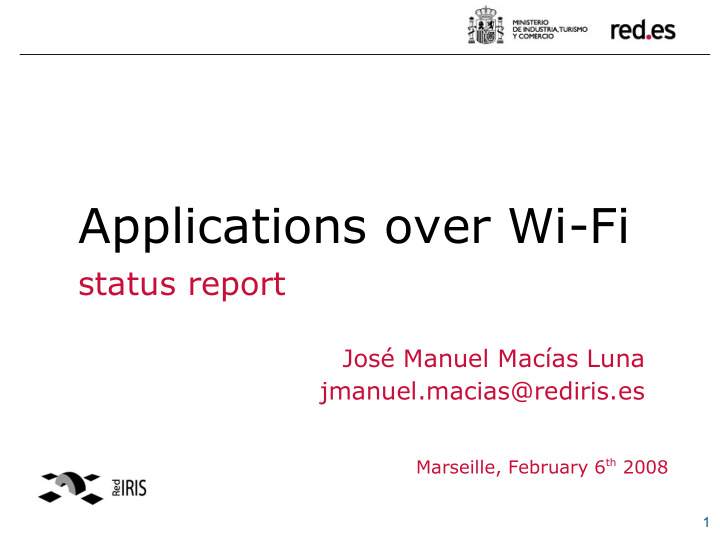



Applications over Wi-Fi status report José Manuel Macías Luna jmanuel.macias@rediris.es Marseille, February 6 th 2008 1
Summary ● Many questions to respond, before starting: • applications • devices • protocols • metrics ● Other issues arraised: • What Wi-Fi standards to use for a testbed? • Technologies like UMA (Unlicensed Mobile Access) • Is this our job ? (I mean, TF-mobility alone?) ● Not considering these other issues: • Handover between APs • Authentication / Reauthentication 2
Applications to consider Reduced the list to these two: ● VoIP (just audio) ● Videoconference (audio and video) ● Excluded for the moment: ● Video (or audio) streaming ● Many forms of video streaming to consider ● Presence and Instant Messaging ● Probably out of scope (minimum requirements, except for ● recommendations we can provide for (un)filtering certain ports) Electronic whiteboards ● Less related with a mobile environment (or maybe not?) ● Collaboration applications (for instance: collaborative edition, desktop ● sharing, etc...) Any other you can tell? ● My idea is to test only standard (not in the sense of popular ) applications ● 3
Devices... what devices? ● A laptop computer... • More computing power: better codecs are used • The most common situation right now • More tools to play with... ● wi-fi enabled phones ? • it depends on the device and OS • Less computing power and more power consumption • worse (simpler) codecs are used • Windows mobile and Symbian being the more popular • Some applications already there... • iPhone and Android to be playing in a near future • Not to forget the UMA-enabled phones (further slide) ● Excluding: • “skype phones” • handhelds and internet tablets • other “toys”: • Nintendo DS, PSP, and many more can do wi-fi and even VoIP, but these gadgets are less common, or less people use them... 4
Protocols ● SIP • Very common in the academic world, and supported by many vendors • SIP is commonly used as the signaling protocol for many VoIP applications • Uses many different codecs ● H323: • Is the other “big one” to consider ● It's not only a protocol but a system specification to other protocols by ITU-T • Many audio, video codecs ● XMPP (aka Jabber): • To be considered also... many ways to use XMPP for real time communication (not just instant messaging) • Also quite used for audio/videoconference and supported by several vendors 5
How to test these applications? ● We can do tests with real applications and provide our subjective impression: • There are surveys describing the user perception after using different audio and video codecs in different situations • but... not our business ? ● or we can do network metrics: • Do not reflect the real user perception • Codecs work in many different ways, although there are experiments with many of the more common standard codecs for VoIP, Video- Conference, and Streaming, not all can be easily measured • These experiments measure several parameters for a given codec, calculating the amount of bandwidth consumed (see next slide) • Tools are available only for a number of platforms • More difficult to make metrics in all the environments ● Some applications have nice stats: • Xmeeting the one I checked so far... • have to ask my multimedia colleague about more... 6
How to test...? (II) ● For VoIP the requirements are minimal (in theory) ● Example: different audio codecs, bitrates, and bandwidth consumed Codec BR NEB G.711 64 Kbps 87.2 Kbps G.729 8 Kbps 31.2 Kbps G.723.1 6.4 Kbps 21.9 Kbps G.723.1 5.3 Kbps 20.8 Kbps G.726 32 Kbps 55.2 Kbps G.726 24 Kbps 47.2 Kbps BR = Bit rate G.728 16 Kbps 31.5 Kbps NEB = Nominal Ethernet Bandwitdh (one direction) iLBC 15 Kbps 27.7 Kbps Source: voip-info.org ● My idea is to compare: ● Same applications with several parameters/codecs in wireless and wired environments ● Compare these results with the theoretical bandwidth usage ● Also... how do different Wi-Fi standards affect these measurements? 7
Unlicensed Mobile Access (UMA) ● a.k.a. Generic Access Network 8
Edificio Bronce Tel.: 91 212 76 20 / 25 Plaza Manuel Gómez Moreno s/n Fax: 91 212 76 35 9 28020 Madrid. España www.red.es
Recommend
More recommend